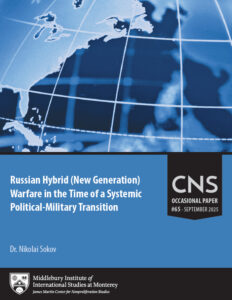September 15, 2025
Nikolai Sokov
Introduction
The field of hybrid warfare studies has largely stagnated over the past decade. The term is almost exclusively applied to Russian policy carrying an emotional rather than an analytical connotation. Yet originally, it was introduced to describe specific types of armed conflicts. American military experts coined the concept to capture non-conventional forms of warfare encountered in Afghanistan, Iraq, and earlier conflicts of the 1990s and 2000s. Over time, it evolved to denote complex, multi-domain operations. The Russian military took interest in the idea, informally adopting elements of the concept without accepting the term itself. In Russia, however, its scope was narrower than in U.S. usage. Whereas “hybrid warfare” in the American sense referred broadly to multi-domain operations, Russia’s “New Generation Warfare” (NGW) described, more narrowly, military operations to be employed in the multi-domain context. After 2014, Western discourse increasingly applied the label “hybrid warfare” to nearly all aspects of Russian foreign policy—creating a methodological problem: if a term applies to everything, it applies to nothing.
This study seeks to reassess the substance and evolution of hybrid warfare and to make sense of Russian hybrid operations by clearly distinguishing between cases that qualify and those that represent more traditional foreign or defense policy. A more precise definition will help clarify the phenomenon and enable the development of a predictive framework to anticipate when, where, and how Russia might pursue hybrid operations in the future. To this end, the study begins by tracing the emergence and evolution of the concept, then identifies the elements of hybrid warfare incorporated into Russian policy, highlighting both similarities to and differences from the original American concept. It concludes with case studies of Russian hybrid operations and considers how hybrid warfare may continue to evolve in Russian strategy.
For the purposes of this study, the term hybrid warfare refers to complex, multi-domain operations that employ a broad array of both military and non-military tools—political, economic, psychological, informational, cyber, and others. Used in combination, these instruments enable the achievement of operational goals without large-scale use of force, primarily by influencing political and decision-making processes in the target country. Typically, the intended outcome of hybrid operations is either a change of political regime in the target state or the strengthening of an existing regime; in some cases, their goal is “victory without war” by disabling the adversary’s ability and resolve to resist.
The military component of hybrid warfare is always limited. It may include special operations, support for paramilitary groups, sabotage, and other forms of deniable or clandestine activity. Even more open use of force is preferably implemented short of war. This study considers use of force integral to hybrid warfare and one of its defining characteristics. By contrast, a multi-domain operation that does not include any use of force is not classified as hybrid warfare.
For example, Russia’s war against Ukraine cannot be considered a hybrid operation because it constitutes a full-scale war. Similarly, China’s activities in Africa do not qualify as hybrid warfare: while they involve investment, construction programs, and other economic tools aimed at expanding Chinese influence as well as support for friendly political regimes, they lack a military component. Along the same lines, Russian information warfare against the West is best described as propaganda—traditional or modern (e.g., through social media)—rather than hybrid warfare. Nevertheless, information operations may form part of hybrid warfare when combined with other domains, including limited military action.
This study assumes that hybrid warfare is a universal phenomenon not limited to any single country. The tendency of the past decade to associate the term exclusively with Russian policy runs counter to its American origins and is methodologically flawed. When applied only to one country, the term becomes a largely emotional and negative label rather than an analytical tool. Hybrid warfare should instead be understood as a toolbox that any state can employ. The nature of the tool does not depend on its ultimate purpose, whether positive or negative. Indeed, Russia has borrowed many elements of its hybrid operations from U.S. practices in the Balkans, Iraq, Afghanistan, and Ukraine. The fact that the United States pursued democratic regime-building while Russia aimed at the opposite outcome does not mean the underlying toolbox differed fundamentally.
That said, Russian hybrid operations differ significantly from those of the United States, both conceptually and in practice: […]

